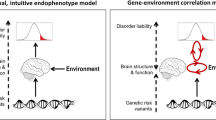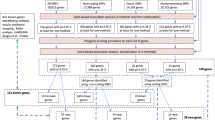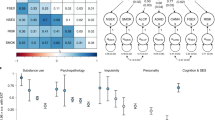Abstract
Arising from: Z. Zhou et al. Nature 452, 997–1001 (2008)10.1038/nature06858; Zhou et al. reply
Psychiatric genetics has been hampered by the fact that initially exciting findings from underpowered studies are so often not replicated in larger, more powerful, data sets. Here we show that the claims of Zhou et al.1 that neuropeptide Y (NPY) diplotype-predicted expression is correlated with trait anxiety (neuroticism) is not replicated in a data set consisting of phenotypically extreme individuals drawn from a large (n = 88,142) non-clinical population. We found no association between NPY diplotype or diplotype-predicted expression and neuroticism. Our reply to Zhou and colleagues forms part of a larger debate2,3,4,5 (see, for example, http://www.nature.com/news/2008/080709/full/454154a.html) about the efficacy and replicability of candidate driven versus genome wide approaches to psychiatric genetics.
Similar content being viewed by others
Main
In their recent study, Zhou and colleagues1 used a candidate gene driven approach to select NPY for investigation as a possible modulator of genetic susceptibility to anxiety and neuroticism. Zhou et al. concluded that “haplotype-driven NPY expression…inversely correlates with trait anxiety” and that their results “help to explain inter-individual variation in resiliency to stress, a risk factor for many diseases”1.
To test their claims we genotyped all seven single nucleotide polymorphisms (SNPs) investigated by Zhou et al.1 in 582 singletons from the extreme 5% tails of the Eysenck Personality Questionnaire neuroticism score distribution from a non-clinical population of 88,142 individuals from the south-west of England2. This sample has close to 100% power to detect a genetic effect accounting for 1.25% of phenotypic variance at an alpha level of 0.01. As Zhou et al. state that NPY explains between 3.3% and 3.4% of variance in trait anxiety1, we have close to 100% power to test their claims.
Diplotypes were assigned to each sample using the five haplotype definitions outlined by Zhou and colleagues1. The three most common haplotypes (H1, H2 and H3) formed six common diplotypes that had each been assigned an expression profile on the basis of lymphoblast NPY messenger RNA levels: low (LL:H1/H1), intermediate (LH:H1/H3, H3/H3 and H1/H2) and high (HH:H2/H3 and H2/H2). Subjects with minor diplotypes (n = 75) were not included in further analyses. Figure 1a shows the distribution of neuroticism scores by diplotype-predicted mRNA expression levels. Neuroticism was compared among diplotype groups by analysis of variance (ANOVA) and regression analysis. The diplotype-predicted values of mRNA expression were taken from Zhou et al.1 as predicted by a co-dominant model. One-way ANOVA on all samples demonstrated no effect of NPY diplotype on neuroticism phenotype (F(5) = 1.38; P = 0.14) nor of NPY-diplotype-predicted expression (F(2) = 1.01; P = 0.36). Furthermore, NPY-diplotype-predicted expression was not correlated with transformed age and sex-regressed neuroticism scores (Fig. 1a). Furthermore, NPY diplotype-predicted mRNA levels did not differ significantly between subjects with high and low neuroticism scores (P = 0.06; Fig. 1b).
a, Regression of transformed age and sex-regressed N scores (mean ± s.e.m.) and diplotype-predicted expression values in 507 subjects (from left to right: H1/H1, n = 151; H1/H3, n = 129; H3/H3, n = 16; H1/H2, n = 139; H2/H3, n = 33; and H2/H2, n = 39). b, Diplotype-predicted NPY mRNA expression levels (mean and s.e.m.) of high neuroticism scorers (n = 265) and low neuroticism scorers (n = 242) compared with a two-tailed t-test (P = 0.06).
If NPY diplotype does in fact exert an effect on neuroticism, then the main effect size must be smaller than 1.25% and probably smaller than 0.5% (power = 87.6%). This lack of replication highlights the problems inherent in candidate gene driven approaches to psychiatric genetics.
Methods
Oligonucleotide primers specific for seven different SNP markers (rs3037354, rs17149106, rs16147, rs16139, rs9785023, rs5574 and rs16475) were used to amplify the target NPY fragments by PCR. Sequencing was performed with Sequenom’s MassARRAY technology6.
Statistical power was calculated by simulation methods and implemented in Perl2. We ran 1,000 simulations of effect sizes ranging from 2.0% to 0.1% and using either 0.05 or 0.01 alpha levels, and calculated the proportion of times that a significant result was obtained.
References
Zhou, Z. et al. Genetic variation in human NPY expression affects stress response and emotion. Nature 452, 997–1001 (2008)
Willis-Owen, S. A. et al. The serotonin transporter length polymorphism, neuroticism, and depression: a comprehensive assessment of association. Biol. Psychiatry 58, 451–456 (2005)
Munafo, M. R., Bowes, L., Clark, T. G. & Flint, J. Lack of association of the COMT (Val158/108 Met) gene and schizophrenia: a meta-analysis of case-control studies. Mol. Psychiatry 10, 765–770 (2005)
Munafo, M. R. et al. Genetic polymorphisms and personality in healthy adults: a systematic review and meta-analysis. Mol. Psychiatry 8, 471–484 (2003)
Abbott, A. Psychiatric genetics: The brains of the family. Nature 454, 154–157 (2008)
Gabriel, S. & Ziaugra, L. SNP genotyping using Sequenom MassARRAY 7K platform. Curr. Protoc. Hum. Genet. Chapter 2 Unit 2.12 (2004)| Article | PubMed |
Author information
Authors and Affiliations
PowerPoint slides
Rights and permissions
About this article
Cite this article
Cotton, C., Flint, J. & Campbell, T. Is there an association between NPY and neuroticism?. Nature 458, E6 (2009). https://doi.org/10.1038/nature07927
Received:
Accepted:
Issue Date:
DOI: https://doi.org/10.1038/nature07927
This article is cited by
-
Common SNPs explain some of the variation in the personality dimensions of neuroticism and extraversion
Translational Psychiatry (2012)
-
Association between neuropeptide Y receptor 2 polymorphism and the smoking behavior of elderly Japanese
Journal of Human Genetics (2010)
-
Zhou et al. reply
Nature (2009)
Comments
By submitting a comment you agree to abide by our Terms and Community Guidelines. If you find something abusive or that does not comply with our terms or guidelines please flag it as inappropriate.




